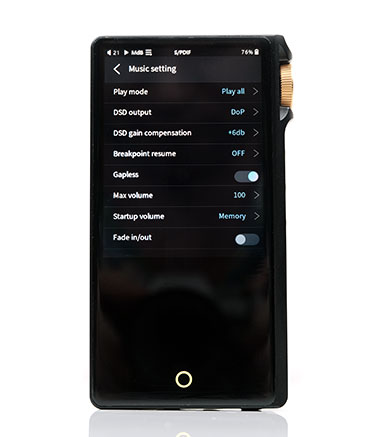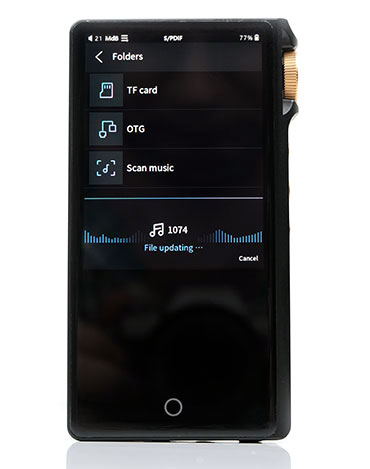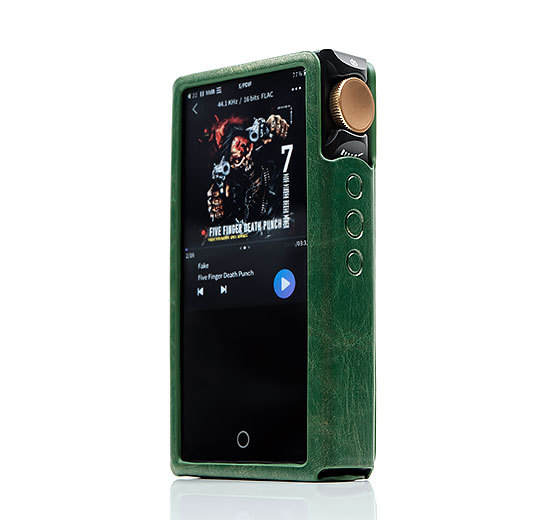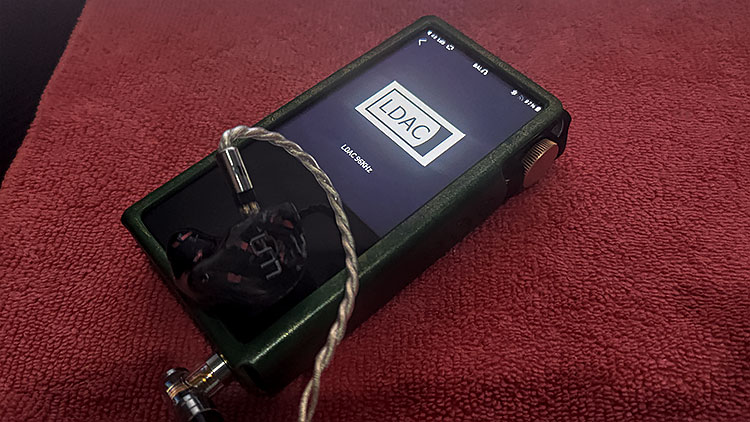N3Pro Software
(Firmware used for the final review notes is V1.2.)
N8 users will be very familiar with the N3Pro software as it is more or less the same ‘HiBy OS’ plus tweaks specific to the N3Pro. I guess that is a benefit given Cayin has had time to bug fix and improve via various firmware upgrades. It does feel quite mature in terms of operation and flow.
Since the CPU is also the same Mips based 1GHz SoC inside the N3Pro the speed feels the same, at least from memory. I cannot tell you exactly as I no longer have the N8 here, (back to base), but it is not as fast as the newer Android implementations on the N6ii or the R5.
Artwork refresh, in particular, feels a bit sluggish in the media management section though navigation and folder drill down feels suitably snappy. Boot up and power-down times are faster than the N6ii by around 10 seconds which also does help.

Navigation
I do love the OS drop-down navigation and all options are really useful and pertinent to how I want to tweak my music playback without having to navigate through endless menu lists.
Gain, operational mode, PO/LO, and USB-DAC settings are all available with a single click. Bluetooth is here also but not WiFi. Given WiFi is limited to OTA and music file transfers it makes sense to leave that one out.
As before with the N8 version, deeper environmental and music settings are available via a swipe up from the bottom of the screen, and here the limitations of that tiny screen kick in with long lists prompting a bit of scrolling up and down. Not too much mind you but a full-length screen would probably have captured them all.
The same is also true for a heavy media database load that creates a long artwork driven list. It can take a while to scroll through it does have a faster alphabet access scroller to the far right.

Playback
There are a total of 3 swipeable playback screens including cover art, lyrics, and track data such as BIT and sample rate, duration, and format. Just above the artwork, in the top right-hand corner, you have 3 small dots which will activate the secondary playback screen icon menu.
From there you can access the current playlist, add a song to an existing or new playlist or simply add it to your favorites. You can also elect to delete the track from the N3Pro from this sub-menu. To return to the main playback screen you can either elect to hit the top left arrow or as I prefer, the bottom Android-like ring
The mechanics of the N3Pro secondary icon menu actually works in a very similar fashion to the N8 implementation though personally, I prefer descriptive word listings over icons as they are more intuitive. However, the diminutive screen size of the N3Pro may have had some influence on the final choice of icons over text.
Track Time Control
You can control the timer also. I do find this timer line quite small to the eye but its touch sensitivity is much better than the old Mango OS slider or the circular HiBy Music system which, thankfully, is now optional.
Unlike the N8, the N3Pro has only one multi-function rotary dial for volume and screen control so you cannot fast forward or reverse the timing of the track. Instead, you have the more traditional playback button control system below the dial which allows you to do the same thing with a long press of the top or bottom button.

Music Settings
You can access the Music settings of the N3Pro via the swipe up menu system just at the bottom of the screen. Here you will find plenty of handy features such as gapless, breakpoint resumption memory, volume control, play through folders, and channel balance adjustments.
Features such as gain control, PO/LO, and the operational mode switching controls are on the main drop-down menu which I think is far more suitable than buried deep in the settings menu.
You can also access the AK4493EQ digital filters via the Music Settings menu set and unlike the N8 you do get all the possible PCM filters (6) as opposed to just 2 on the flagship. How much you value 6 over 2 depends on how much use you make out of them. Slow roll-off and fast roll-off tend to be the most noticeable sound quality changes.
Personally, I hardly touch digital filters. The different operational modes, tubes and solid-state, as well as the EQ system, will have a much more dramatic and involving effect on the N3Pro sound signature.

Media Management
The Media and playback features are front and center on the home screen and do not require any sub-menu navigation. This format pitches the N3Pro much more as a dedicated music player than Android platforms, similar in emphasis to Sony and Lotoo’s OS. It is simpler but much more direct.
The tag-focused library is broken down into Song, Artist, Album, and genre. You also have the ability to drill down via the physical folder and create playlists and favorites via the home screen as well as a sub-menu option to add to these lists via the playback screen.
Tagging accuracy from the scanning will depend on how you tag your own tracks but on a 2300 FLAC file scan I found the tag scanning to be accurate. Anything missed was because I have not embedded the correct data or artwork.
LQ/HQ
Once stored each individual track gets the HQ/LQ treatment which basically means Hi-Res or Low-Quality to designate your lossless and lossy track formats. You will see this in a small blue tag below the main song title in the library.
Genre Faux Pas
Maybe I am a lone soldier for the cause but the genre UI on the N3Pro, like the N8, leaves much to be desired in terms of ease of use. This is especially so if you have a large number of albums and tracks using the same genre tag because of the lack of proper drill down and grouping. There is no artist and/or album grouping so it’s all a bit flat and time-consuming to use.
You will find that in most HiBy OS implementations on their own DAPs, Android app, older FiiO DAPs, and the list goes on. It is not Cayin’s fault but I do wish HiBy would change that for the benefit of ease of use for all clients and customers.

File Management
Simpler folder media management is split into the key storage areas including TF card and OTG. How big the card or OTG library will dictate the speed of the buffer in terms of processing and list generation. You will also find the general media scan function inside the main ‘Folder’ home page sub-menu.
Media scanning is pretty quick up to 64GB in both TF and onboard memory. I say 64Gb as I never carry anything larger in case of corruption. My previous 128GB version lasted less than a year which was a waste of money.
With the 64GB cards, the N3Pro read access capability did not present any issues so you are talking seconds rather than minutes for the media library to generate. The process and speed for read-access to 64GB flash sticks via OTG was the exact same as the microSD card performance so no issues there.
Wireless Options
Currently, you have two wireless connectivity options on the N3Pro, Bluetooth, and a ‘gimped’ WiFi which is only for OTA firmware updates.
Having upgraded twice already before writing this review I can say the OTA is fairly stable and fast enough to use without resorting to local downloads. Just note you do need a memory card inside to receive the downloaded file and install.
Bluetooth is actually a step up on the N8 and the N6ii at BT5.0 versus 4.2 so that makes the N3Pro a solid 2020 creation for the plethora of TWS and streaming devices out there in the market today.
However, codecs at play are the same as the two higher-priced units with SBC, aptX, and LDAC right up to HiBy’s own hi-res UAT decoding capability. You can choose the codec you prefer or set the LDAC to ‘best quality’ or ‘preferred’. I did note though, no ACC decoding capability which might disappoint Apple fans.
HiByLink
With bi-directional capability, you can also activate the HiByLink option within the Bluetooth menu on the N3Pro and pair it with a smartphone’s own HiBy Music App to create the remote control service.
I find this very useful when using the N3Pro in line-out mode to a dedicated desktop amp. From the smartphone side you can control the library and playback but core music and system settings you will have to adjust directly from the N3Pro.
One important note for using HiByLink. You need to turn it on both source and N3Pro as the receiver then turn off and turn on BT functionality once again before you make the link. Once you do the smartphone will pick up your N3Pro library as a new and accessible media library (scan activated).
Sound Impressions
Tube Summary
The sound of the N3Pro ultimately depends on which operational mode output you want to work with. The two tube modes, Triode, and Ultra-linear are smoother and warmer than the solid-state options but differ from each other quite markedly.
The Triode mode defers to a slightly enhanced warmer low-end and a mids and treble that falls back a bit in presence whereas Ultra-linear is more full-on, spacious, and with a livelier midrange performance.
I prefer the Ultra-linear mode with our testing gear. It has a better balance with modern pop and rock and a beautifully smooth and forward vocal delivery. It is the perfect operational mode for clean mid-centric monitors that need a bit of sweetness or a euphonic vocal to sound optimal such as Cayin’s own YB04 or Gaudio’s triple-driver reference tuned Nair.
I would go with the triode mode if the treble or sibilance was a shade too lively or you want something a bit smoother and more relaxed for acoustical/vocal mixes and soul classics. It feels more ‘stripped down’ and in keeping for intimate performances that do not use walls of harmonized vocal or energetic percussion mixes.
I actually found the Campfire Audio Ara to be a good pairing for the Triode mode with its focus on fine detail and forward vocal presence. The Ara’s almost classic hi-fidelity stereo presentation and 1-2k bump are a good compliment to the Triode’s more relaxed tone whereas the Ultra-linear seems to almost overload the mids of the Ara.
Solid State Summary
The solid-state operational mode of the N3Pro is energetic and musical sounding with good low-end elevation and a lively percussion that seemed to play out with our tested monitors.
The tone is a little cooler compared to the two tube modes with percussion offering a slightly elevated presence. Going 4.4mm balanced also offers better separation and staging width compared to its 3.5mm equivalent so it can sound airy and deeper also.
Vocals are clean and clear, especially strong female vocals such as Sia and Ruelle. However, I do prefer the tube tone compared to the solid-state unbalanced performance. Vocals sound sweeter with more presence on the ultra-linear tube mode whereas they tend to sound comparatively neutral on the solid-state side.
The N3Pro solid-state operational mode hits the right spot with that modern pop sound or a stripped sound soulful performance where low-end driving rhythms have more prominence. Going balanced will give you an additional dimension to the staging complexity with better depth and a lift in the comparative dynamic range performance also.
If you are using hybrid monitors with dynamic drivers such as the UM MEST, balanced will sound the more robust of the two solid-state outputs. The additional power and better channel separation delivers a punchier low-end and fills the stage a lot better than going single-ended.
Solid State Timbre
The magic of the N3Pro is how it can deliver 3 to 4 unique colorations that are entirely unique from each other. However, the impact and preference of each timbre do depend to a degree on the monitors or headphones you want to use.
For example, balanced nearly always has a better level of PRaT compared to its more neutral and slightly compressed single-ended alternative. The timbre is cooler than the tube counterpart but the sense of power, like a boxer’s planting of the feet before he throws a punch, is stronger.
You could argue that out of the four ‘tones’ the 4.4mm output sound has the most evenly weighted harmonic balance and the most ‘accurate’ of the 4 operational modes.
Also, most headphones will profit from that improved perception of dynamic range, particularly with a bass fundamental that provides a bit of appreciated weight to lower-mids instrumental timbre and bass specific kick drums and synth beats.
The additional power from the 800mW also helps considerably helps with a better sense of scale that helps flesh out the low-end impact compared to the softer or more neutral single-ended sound.
If anything, the 3.5mm single-ended output of the N3Pro is the tonal weak link. Not that it is poor or compressed sounding but comparatively speaking it lacks a particular knockout punch that the balanced or tube modes can deliver. Vocals are lighter in weight, instruments are more neutral in coloration and the bass is relatively linear.
Tube Timbre
The two tube modes timbre go in a very different direction. The Ultra-linear mode is likely to be the one that everyone will immediately bias to on initial listening. Mids really play to the fore here with a sweet but rich lower-mids instrumental timbre compared to the cooler solid-state sound.
Vocals also sound bigger, more intimate, and natural sounding. There is a slight fade in the treble to ensure the sound is sweet right up to the percussion and high-pitching vocal performance but you will not really notice that because it still sounds energetic to my ear.
Contrast that with the Triode timbre which sounds a little more rounded to me giving it more of a relaxing sound. I mentioned before it has this stripped-down vibe possibly due to the lack of energy in the lower-mids and mid-bass compared to the Ultra-linear signature.
This tends to leave a little space between the absolute low-end of the N3Pro Triode tone and the vocals which enhance the perception of a stronger vocal presence. Vocals are still smooth and broad sounding but stand out more on their own with less “fizz” in terms of higher pitching spatial imaging.
Staging
If you are looking for the most complete staging experience then the 4.4mm balanced output of the N3Pro is ideal, especially with headphones where the additional power will deliver superior dynamic range to their performance.
The N3Pro Ultra-linear Tube mode will offer excellent width compared to the 4.4mm output with monitors but will bring in vocals a lot closer and shave a bit a little in terms of absolute depth and power.
In most instances, I can live with that though with stronger bass performances from hybrid monitors such as Empire Ear’s Odin I normally switch to the N3Pro balanced output to tease out a bit more slam and space.
With reference monitors or linear BA configurations such as the Campfire Audio Ara, I do prefer the more intimate staging of the Triode operational mode but on the understanding that I am not going to get the same width or presence as the Ultra-linear or balanced solid-state mode output.
At times, with more ethereal sounding or more expansive sounding gear the Triode mode can sound a little narrow or compressed and does not fill the stage quite likes its more energetic Ultra-linear mode sibling.
In the middle of it all is the 3.5mm single-ended solid-state mode which, for me is very neutral throughout. Not a clean sound, because compared to something like the DX160, the N3Pro single-ended sound is still thick, planted, and not as bright. Rather, relative to the other modes it has the most neutral delivery in terms of stage positioning, depth, and height.
Wireless Performance
I think it is important to try for an LDAC connection with the N3Pro if you decide to go with Bluetooth audio. Most phones have it now but with a tube output, it can sound very soft and loose once you drop down to lossy more compressed audio codecs such as SBC or even aptX.
The 3.5mm and balanced solid-state have less of an issue with their cleaner sound signature but you do notice the difference with the lack of high-frequency resolution on SBC compared to LDAC.
Using an Asus Rog Phone 3, the LDAC performance was actually very impressive, perhaps better than my older Note 9 which is now gathering dust.
TIDAL Masters via the Rog 3 to the N3Pro was optimal with balanced solid-state overall. A lot of TIDAL stuff is bass-heavy and going balanced adds the necessary power and dynamic range to these tracks that tend to lack a bit of substance and impact on the single-ended alternatives.







